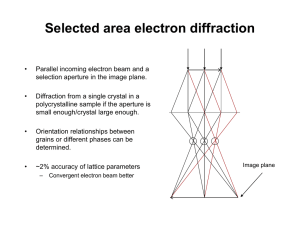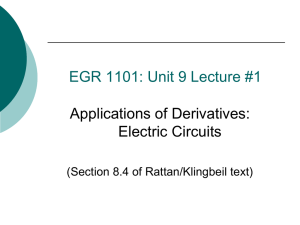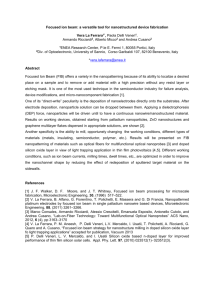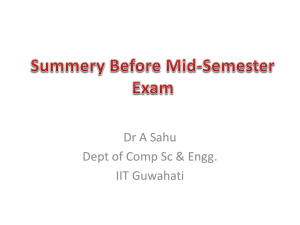PFC/JA-90-34 MULTIMODE AUTORESONANCE Chiping Chen and Jonathan Wurtele
advertisement
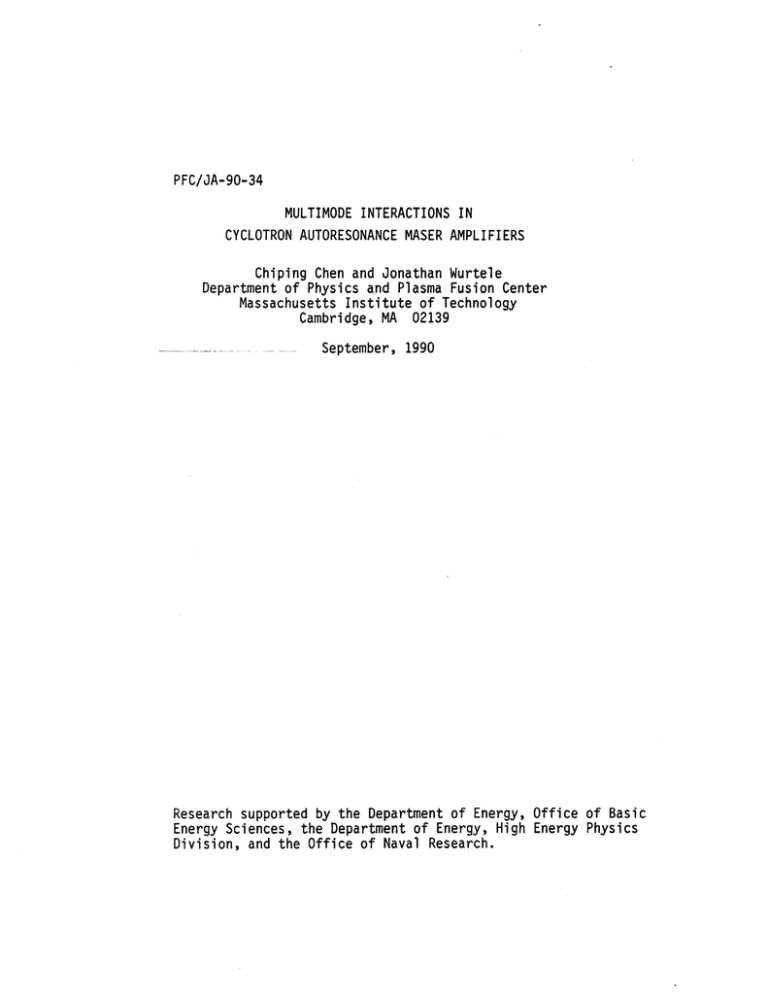
PFC/JA-90-34
MULTIMODE INTERACTIONS IN
CYCLOTRON AUTORESONANCE MASER AMPLIFIERS
Chiping Chen and Jonathan Wurtele
Department of Physics and Plasma Fusion Center
Massachusetts Institute of Technology
Cambridge, MA 02139
September, 1990
Research supported by the Department of Energy, Office of Basic
Energy Sciences, the Department of Energy, High Energy Physics
Division, and the Office of Naval Research.
MULTIMODE INTERACTIONS IN
CYCLOTRON AUTORESONANCE MASER AMPLIFIERS
Chiping Chen and Jonathan S. Wurtele
Department of Physics and Plasma Fusion Center
Massachusetts Institute of Technology
Cambridge, Massachusetts 02139
ABSTRACT
The interaction of transverse eigenmodes with a relativistic electron beam is analyzed in an overmoded cyclotron autoresonance maser amplifier, using a nonlinear selfconsistent model and kinetic theory. It is shown that all of the coupled modes grow
with the dominant unstable mode at the same growth rate, but suffer different launching
losses. The phases of coupled modes are locked in the linear and nonlinear regimes. Simulations indicate that the rf power distribution among the interacting modes at saturation
is insensitive to input power distribution but sensitive to detuning.
PACS numbers: 42.52.+x, 52.75.Ms, 52.35.Mw
1
One of the most intriguing problems in the generation of coherent radiation using
a relativistic electron beam is the interaction of multiple electromagnetic eigenmodes
with the electron beam. In free electron laser (FEL) oscillators', 2 and gyrotrons, mode
competition determines the temporal behavior of the eigenmodes of the cavity and the
radiation spectrum. Multimode phenomena also occur in overmoded amplifier systems,
where the temporal dependence of the eigenmodes is usually sinusoidal. In such cases,
the eigenmodes evolve spatially as a result of the interaction with the electron beam.
A nonlinear multimode theory is indispensable in order to predict the rf power in
each mode. Multiple waveguide mode interactions have been investigated using linear
theory4 and computer simulations' for FEL amplifiers, but detailed comparisons between
theory and simulations are not (yet) available. There have been few theoretical studies
of multimode interactions in cyclotron autoresonance maser (CARM) amplifiers'-" in
waveguide configurations, despite the fact that many planned CARM amplifier experiments will operate in an overmoded waveguide.
In this letter, we present a general treatment of multimode interactions in an overmoded single-frequency CARM amplifier, using a nonlinear self-consistent model and
kinetic theory. A complete set of CARM amplifier equations with multiple modes, which
are derived from the standpoint of particle-wave interactions (similar to the FEL equations derived by Kroll, Morton, and Rosenbluth"2 ), are integrated numerically to calculate
the linear and nonlinear evolution of coupled transverse eigenmodes and of the relativistic electron beam. In addition, use is made of the linearized Maxwell-Vlasov equations
and the Laplace transform to derive a dispersion relation and amplitude equations for
the CARM instability with an arbitrary number of vacuum transverse-electric (TE) and
transverse-magnetic (TM) waveguide modes. The Laplace transform analysis allows for
analytical calculation of launching losses and the three-dimensional radiation field profile.
Although the present treatment is devoted specifically to the CARM amplifier, we believe
2
that the basic ideas are applicable to a large -class of amplifier-type free electron devices
including free electron lasers, gyrotron traveling-wave tubes,'" Cherenkov masers,14 etc.
We consider the CARM interaction', of a relativistic electron beam with a copropagating electromagnetic wave (w, k) in a lossless cylindrical waveguide of radius r,
immersed axially in the uniform magnetic field BoF.. The cyclotron resonance condition is
o = kzv, + lc/-y. Here, v, and y are, respectively, the axial velocity and relativistic mass
factor of the beam electrons; I is the harmonic number; 0, = eBo/mc is the nonrelativistic
cyclotron frequency; m and -e are the electron mass and charge, respectively; and c is
the speed of light in vacuo. For simplicity, we present the analysis for the multimode
CARM interaction involving an arbitrary number of vacuum TE modes with azimuthal
dependence e'a, maintaining the general features of multimode phenomena (which will
be discussed elsewhere1 5 ).
It can be shown that a complete set of nonlinear equations describing an overmoded
CARM amplifier with multiple TE1, modes can be expressed in the dimensionless form8"s5
d
=-
Z
di
px1
di
PZ 1
W
(r,
PL nkL0t['y
dA
d~n
dP.
r) \X.(r,-+
[;
di
d
r,) 17 -
- + d -A,
0-0n)Anin
- + - )An(i) expji[#
2P
explii0
)3n Xn(rL, r,) Ze~
3
+
An Cos
1 + dS, y
3di
PZ+
d2
(1)
Pzf
__
+-
X, (r, r)Ancos bfl,
dj
sn ]
,
(2)
PZ
i sin On$ +P.
On,
obn},
di COS
(3)
3
,
(4
+n(i)]
+ Sn(M)
where n is a positive integer and the normalized coupling constant g, is defined by
04(,
- 1)
Equations (1)-(3) describe the dynamics of each individual particle, and Eq. (4)
governs the slowly varying wave amplitude A,(i) and phase shift 6(i) for each TEI,
mode.
In the simulations, typically, we use more than 1024 particles.
In Eqs. (1)-
(4), i = wz/c is the normalized interaction length; w = 27rf is the angular frequency
of the input signal;
P2
=
ne
= Q,/w is the normalized nonrelativistic cyclotron frequency;
pz/mc = -yO., P± = p±/mc = y#3±, and y = (1 +
p2
+
p2 )1/2
are, respectively,
the normalized axial and transverse momentum components, and the relativistic mass
factor of an electron;
lb
is the beam current;
IA =
mc 3 /e a 17 kA is the Alfv6n current;
Xn(rL,rg) = Jo(kar,)Jj(karL) and W.(rL,r,) = Jo(kr,)J(k.rL)/krL are geometric
factors; Jo(x) is the lowest order Bessel function; J((x) = dJ(x)/dx is the derivative of
the first-order Bessel function; u,, is the nth zero of Jj(x); kn = un/r,. is the transverse
wavenumber associated with the TEin mode; go
= w/ck.,
= (1
-
c2 kW 2 )- 1 / 2 is the
normalized phase velocity of the vacuum TEIn waveguide mode; rL = p±/mlc is the
electron Larmor radius; r, is the electron guiding-center radius which is assumed to be
constant; < ... > denotes the ensemble average over the particle distribution.
The rf power flow over the cross section of the waveguide for the TE 1. mode, Pn(z),
is related to the normalized wave amplitude A, by the expression
1n() mc I
.e)=
-(2
(v2 _)[,
V)
[
2 2
+ond-
+ --
nA2()
(5)
where m 2 c5 /e 2 2 8.7 GW. Equations (1)-(4) are readily solved numerically to yield the
three-dimensional radiation field profile and the distribution of rf power among coupled
4
modes in the multimode CARM interaction. For the simulation results presented below,
the particles are loaded such that the right-hand side of Eq. (4) vanishes at z = 0,
corresponding to an initially unbunched electron beam.
By performing the Laplace transform of the linearized Maxwell-Vlasov equations,
a dispersion relation and amplitude equations can be derived for the multimode CARM
interaction, with an arbitrary number of vacuum TE and TM waveguide modes coupling
to the electron beam.
thin (kar,
<
For example, applying our results to the coupling of a cold,
1), azimuthally symmetric electron beam with the TE1, modes at the
fundamental cyclotron frequency (1 = 1), and assuming dEn(O)/dz = 0, the Laplace
transform of the equations for the amplitudes E.(z)
-
A,.(z) exp[ik.,z+ 6,(z)] to leading
order in c2 kI/(w - Q./- - khv.) 2 can be expressed in the matrix form'"
(2
2 +
W2)n,k2,(W
E.
2
N
+ C2 s 2 )
(w - Qr /y + ivs)2
,,
N2
= sEn(0) +
,,kr,v,
,E (w -
,/y + iv.s)2
In Eq. (6), s = ik is the Laplace transform variable;
En,(0)z.
(6)
, = v./c and OJ. = v±/c are,
respectively, the normalized axial and transverse velocities of the equilibrium beam electrons; ckN is the largest cut-off frequency below the operating frequency w; and the
dimensionless coupling constants
4ni=
(
, are defined by
[
Xn(rL, r,)Xn,(rL, r,)
-yo. kA/ [(V2 - 1)(V2, -
1)]1/2j,(Vn)J,(Vn,)
Therefore, the amplitudes En(z) and the dispersion relation can be obtained by solving
Eq. (6) and performing the inverse Laplace transform of
Zn(s).
For two coupled modes, TEI, and TEIn, it is readily shown from Eq. (6) that the
dispersion relation is
5
=
[Efllki(kW + k
-
2w
k, -C
kj
{2 + k.2-'
) +
k (k2 + k
02~v
w)
-
When the two modes are well separated and enk2(k + kl,
k-
-
-
c2/2)
w 2 /c 2 ) >
W2/c 2), corresponding to the beam cyclotron mode, w = kzv, +
(7)
fk(k2
+
c/jy, in resonance
with the TEI, mode, w = c(k! + kz)1 / 2 , the coupled-mode dispersion relation in Eq. (7)
becomes the usual single-mode dispersion relation'
+
C2
9
e"4'k2(w 2
(w
-
-c 2 k2)
-
k~v.)
2
for the TE1 , mode.
Typical results from the computer simulations and kinetic theory are summarized
in Figs. 1-3. Figure 1 shows the dependence of rf power, in the TE11 and TE12 modes,
on the interaction length z for (a) single-mode CARM interactions and (b) the CARM
interaction with both modes coupling to the beam. The system parameters in Fig. 1 are
beam current
lb
= 500 A, beam energy Eb = 1.0 MeV (y = 2.96), initial pitch angle
OP= O'3o/0,o = 0.6, waveguide radius r. = 2.7 cm, and axial magnetic field BO = 3.92
kG, corresponding to the TE1 1 mode in resonance, and the TE12 mode off resonance, with
the electron beam. The solid curves are the simulation results obtained by integrating
numerically Eqs. (1)-(4) with 1024 particles; The dashed curves are obtained analytically
from Eq. (6).
The inclusion of the coupling of the TE11 and TE12 modes results in
instability for the TE12 mode as seen in Fig. 1(b), while the single-mode theory predicts
complete stability for the TE12 mode as seen in Fig. 1(a). In fact, in Fig. 1(b), the
TE12 mode grows parasitically with the dominant unstable TE11 mode, and the two
coupled modes have the same spatial growth rate -ImAk,
6
> 0, corresponding to the
most unstable solution of the dispersion relation in Eq. (7). Because the TE11 mode is in
resonance with the beam mode and the TE12 mode is detuned from resonance, the TE12
mode suffers greater launching losses than the TE11 mode.
The simulation also shows that the relative rf phase AO(z) = (k, 2 - k, 1 )z + 62 (z)
-
61(z) for the coupled modes is approximately constant in the exponential gain regime.
Such a phase-locking phenomenon is expected from linear theory, because the dispersion
relation in Eq. (7) yields a unique solution of k. with a negative imaginary part, which
determines the spatial growth rate and phase shifts for both modes in the exponential
gain regime. What is remarkable is that phase locking persists even in the nonlinear
regime, at least for some finite interaction length after saturation.
This reveals two
general features of the multimode CARM interaction: (1) all of the coupled modes have
the same growth rate, but suffer different launching losses which depend upon detuning
characteristics; (2) the phases of coupled waveguide modes are locked in the exponential
gain regime, and remain locked for some finite interaction length after saturation.
Another interesting feature of the multimode CARM interaction is that the rf power
distribution among the coupled modes at saturation is insensitive to the small-input rf
power distribution at z = 0. Figure 2 shows the results of the simulations for the coupling
of the TE11 and TE12 modes with two different distributions of input rf power. In Fig. 2,
the two solid curves depict the linear and nonlinear evolution of rf power in the TE12 mode
obtained from the simulations with the two input rf power distributions: (a) Po(TE 11 )
= 1.0 kW and PO(TE12 ) = 1.0 kW, and (b) Po(TE11 ) = 1.0 kW and Po(TE12 )
=
1.0 W,
while the two dashed curves are the corresponding analytical results from Eq. (6). Here,
only the TE 12 mode is plotted because the TE11 mode remains virtually unchanged for
the two cases.
Figure 3 depicts the detuning characteristics of the saturated rf power distribution
among four coupled TE1 , modes (n = 1, 2,3,4), as obtained from the simulation with an
7
input power of 100 W per mode. By increasing the axial magnetic field B0 in Fig. 3, the
beam mode is tuned through the resonances with the TE11 , TE1 2 , TE1 3 , and TE1 4 modes
at Bo = 3.74, 4.29, 5.33, and 6.98 kG, respectively. The fractional rf power for a given
mode reaches a maximum at its resonant magnetic field, while the power decreases rapidly
for off-resonance modes. In the transition from one resonance to another, however, two
adjacent competing modes can have comparable rf power levels at saturation.
In summary, we have presented a general treatment of multimode interactions in an
overmoded CARM amplifier using a nonlinear self-consistent model and kinetic theory.
Good agreement was found between the simulations and kinetic theory in the linear
regime.
It was shown analytically, and confirmed in the simulations, that all of the
coupled waveguide modes grow with the dominant unstable mode at the same spatial
growth rate, but suffer different launching losses which depend upon detuning. Phase
locking occurs among coupled waveguide modes in the linear and nonlinear regimes. The
saturated rf power in each mode was found to be insensitive to input power distribution,
but sensitive to detuning. An accurate calculation of the growth rate and saturation
levels in overmoded CARM amplifiers requires the use of a multimode theory in the
linear and nonlinear regimes. We believe that the present analysis can be generalized to
treat multimode phenomena in various free electron devices.
ACKNOWLEDGMENTS
The authors wish to thank B.G. Danly for helpful discussions.
This work was
supported by the Department of Energy, Office of Basic Energy Sciences, the Department
of Energy, High Energy Physics Division, and the Office of Naval Research.
REFERENCES
1.
Ya.L. Bogomolov, V.L. Bratman, N.S. Ginzburg, M.I. Petelin, and
8
A.D. Yanakovsky, Opt. Commun. 36, 109 (1981).
2.
T.M. Antonsen, Jr. and B. Levush, Phys. Rev. Lett. 62, 1488 (1989); L. R. Ellis,
G. Ramain, J. Hu, and A. Amir, ibid, 55, 424 (1986).
3.
K.E. Kreischer and R.J. Temkin, Phys. Rev. Lett. 59, 547 (1987).
4.
E. Jerby and A. Gover, Phys. Rev. Lett. 63, 864 (1989).
5.
R.A. Jong, W.M. Fawley, and E.T. Scharlemann, SPIE Vol. 1045, 18 (1989).
6.
G. Bekefi, A. DiRienzo, C. Leibovitch, and B.G. Danly, Appl. Phys. Lett. 54, 1302
(1989).
7.
V.L. Bratman, G.G. Ginzburg, G.S. Nusinovich, M.I. Petelin, and P.S. Strelkov,
Int. J. Electron. 51, 541 (1981), and references therein.
8.
A.W. Fliflet, Int. J. Electron. 61, 1049 (1986).
9.
K.R. Chu and A.T. Lin, IEEE Trans. Plasma Science 16, 90 (1988).
10. K.D. Pendergast, B.G. Danly, R.J. Temkin, and J.S. Wurtele, IEEE Trans. Plasma
Science 16, 122 (1988).
11.
C. Chen and J.S. Wurtele, Phys. Rev. A40, 489 (1989).
12. N.M. Kroll, P.L. Morton, and M.N. Rosenbluth, IEEE J. Quantum Electron. QE-17,
1436 (1981).
13. L.R. Barnett, L.H. Chang, H.Y. Chen, K.R. Chu, W.K. Lau, and C.C. Tu, Phys.
Rev. Lett. 63, 1062 (1989), and references therein.
14. See, for example, High Power Microwave Sources, edited by V.L. Granatstein and
I. Alexoff (Artech House, Boston, 1987), p. 397.
15. C. Chen and J.S. Wurtele, in preparation (1990).
FIGURE CAPTIONS
Fig. 1
The rf power in the TE11 and TE12 modes is plotted as a function of
9
interaction length z for (a) single-mode CARM interactions and (b) the
CARM interaction with the coupled modes. Note in Fig. 1(b) that the
TE12 mode grows parasitically with the dominant unstable TE11 mode
at the same spatial growth rate due to mode coupling, despite the differences
in launching losses.
Fig. 2
The TE12 rf power is plotted as a function of interaction length for a CARM
with the TEII and TE12 modes coupling to the beam. Here, the two solid
curves depict the linear and nonlinear evolution of rf power for the TE12
mode obtained from the simulations with two input rf power distributions:
(a) Po(TE11 ) = 1.0 kW and PO(TE12 ) = 1.0 kW, and (b) PO(TE1 1) = 1.0 kW
and Po(TE12 ) = 1.0 W, while the two dashed curves are the corresponding
analytical results from Eq. (6).
Fig. 3
The fractional rf power at saturation in four coupled TEI, modes is plotted
as a function of detuning. Here, the values of the resonant magnetic field for
the TE11 , TE12 , TE13 , and TE14 modes correspond to BO = 3.74, 4.29, 5.33,
and 6.98 kG, respectively.
10
--108
(a)
SIMULATION
LINEAR THEORY
I O7
TEI
106
w
3:
0
CL
104
u- \03
Q3
1
,'TE
10 2
101
0. 0
200.0
100.0
300 0
109
c..
-
108
(b)
SIMULATION
LINEAR THEORY
TEI
106
u
3:
0
u-
105
104
I03
f = 18GHZ Bo= 3.92kG
epO= 0.6
y = 2.96
102
Ib = 500A
rw =2.7cm
101
0.0
200.0
100.0
Z (cm)
Fig. 1
11
300.0
1o
SIMULATION
LINEAR
THEORY
105
104
j 3
f = 18GHz
TE
02
Uj-
101
rw = 2.7cm
12
Bo= 3.92kG
y= 2.96
TE 12
6 O.6
-p
Ib= 5OOA
100
0. 0
50.0
100.0
Z (cm)
Fig. 2
12
150.0
200.0
I
1.00
'
'
I
I
'
I
I
-
I
'
I
'
...--
S--/f'/
-
I
U
--
TEII
- TE12
TE 13
TE 14
0.10 --
< 0.01
I
U.
20.01
--
=-f
= 18GHZ~
r = 5cm y =2.96
e =0.6
S0Ib0A
b
3.0
4.0
5.0
I
6.0
Bo(kG)
Fig. 3
13
PO I
7.0
8.0


